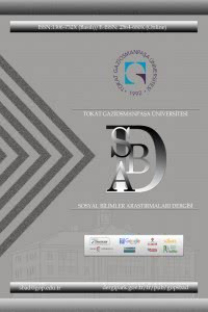REVİZE EDİLMİŞ DUYGUSAL TUTARLILIK ÖLÇEĞİNİN (R-DTÖ) DEĞERLENDİRİLMESİ: TÜRKÇE GEÇERLİLİK VE GÜVENİRLİLİK ÇALIŞMASI
EVALUATION of THE REVISED SENSE of COHERENCE SCALE (SOC-R): TURKISH VALIDITY and RELIABILITY STUDY
___
- Aksayan, S. ve Gözüm, S. (2002). Kültürlerarası Ölçek Uyarlaması İçin Rehber I: Ölçek Uyarlama Aşamaları ve Dil Uyarlaması. Hemşirelik Araştırma Dergisi, 4(1), 9- 14.
- Antonovsky A.(1979). Health, Stress, and Coping, Jossey-Bass Publishers.
- Antonovsky A.(1993). The Structure and Properties of The Sense of Coherence Scale. Social science & medicine, 36(6), 725–33.
- Antonovsky, A. (1987). Unraveling The Mystery of Health: How People Manage Stress and Stay Well. San Francisco, CA: Jossey-Bass.
- Antonovsky, A. (1997) Salutogenese: Zur Entmystifizierung der Gesundheit. Tübingen, DGVT.
- Arciero, G., Guidano, V. F. (2000). Experience, Explanation, and The Quest for Coherence. In R. A. Neimeyer & J. D. Raskin (Eds.), Meaning-making frameworks for psychotherapy, 91–118.
- Bachem, R., Maercker, A. (2016). Development and Psychometric Evaluation of A Revised Sense of Coherence Scale. European Journal of Psychological Assessment, 34, 206–215.
- Baltes, P. B., Staudinger, U. M. (2000). Wisdom: A Metaheuristic (Pragmatic) to Orchestrate Mind and Virtue Toward Excellence. American Psychologist, 55(1), 122-136.
- Cohen, J. (2013). Statistical Power Analysis for The Behavioral Sciences. New York: Routledge.
- Cronbach, L. J. (1951). Coefficient Alpha and The İnternal Structure of Tests. Psychometrika, 16(3), 297-334.
- Çeçen, A. R. (2008). Üniversite Öğrencilerinde Yaşam Doyumunu Yordamada Bireysel Bütünlük (Tutarlılık) Duygusu, Aile Bütünlük Duygusu ve Benlik Saygısı. Eğitimde Kuram ve Uygulama, 4(1), 19-30.
- Eriksson, M., Lindström, B. (2005). Validity of Antonovsky’s Sense Of Coherence Scale: A Systematic Review. Journal of Epidemiology & Community Health, 59(6), 460-466.
- Eriksson, M., Mittelmark, M. B. (2017). The Sense of Coherence and Its Measurement. In: Mittelmark MB, Sagy S,Eriksson M, Bauer GF, Pelikan JM, Lindstrom B, et al., editors. The Handbook of Salutogenesis. Cham (CH): Springer Copyright, 97–106.
- Feldt, T., Lintula, H., Suominen, S., Koskenvuo, M., Vahtera, J., Kivimaki, M. (2007). Structural Validity and Temporal Stability of The 13-Item Sense of Coherence Scale: Prospective Evidence From The Population-Based HeSSup Study. Quality of Life Research: An International Journal of Quality of Life Aspects of Treatment, Care and Rehabilitation. 16(3), 483–93.
- Goodman, L. A. (1961). Snowball Sampling. The Annals of Mathematical Statistics, 32, 148-170.
- Gruszczynska, E. (2006). What is Measured by The Orientation to Life Questionnaire? Construct validity of the instrument for the Sense of Coherence measurement. Polish Psychological Bulletin. 37(2), 74.
- Hu, L. T., Bentler, P. M. (1999). Cutoff Criteria for Fit İndexes in Covariance Structure Analysis: Conventional Criteria Versus New Alternatives. Structural Equation Modeling: A Multidisciplinary journal, 6(1), 1-55.
- Jöreskog, K. G., Sörbom, D. (1996). LISREL 8: User's Reference Guide. Lincolnwood, IL: Scientific Software International.
- Kline, R. B. (2015). Principles and Practice of Structural Equation Modeling. New York: Guilford Publications.
- Marsh, H. W., Hau, K. T., Wen, Z. (2004). In Search of Golden Rules: Comment on Hypothesis-Testing Approaches to Setting Cutoff Values for Fit İndexes and Dangers in Overgeneralizing Hu and Bentler's (1999) Findings. Structural Equation Modeling, 11(3), 320-341.
- Marsh, H. W., Lüdtke, O., Muthén, B., Asparouhov, T., Morin, A. J., Trautwein, U., Nagengast, B. (2010). A New Look at The Big Five Factor Structure Through Exploratory Structural Equation Modeling. Psychological Assessment, 22(3), 471.
- Mc Gee, S. L., Höltge, J., Maercker, A., Thoma, M. V. (2018). Evaluation of The Revised Sense of Coherence scale in A Sample of Older Adults: A Means to Assess Resilience Aspects. Aging & mental health, 22(11), 1438-1447.
- Park, C. L. (2010). Making Sense of The Meaning Literature: An Integrative Review of Meaning Making and Its Effects on Adjustment to Stressful Life Events. Psychological Bulletin, 136(2), 257-301.
- Rajesh, G., Eriksson, M., Pai, K., Seemanthini, S., Naik, D. G., Rao, A. (2016). The Validity and Reliability of The Sense of Coherence Scale Among Indian University Students. Global Health Promotion. 23(4), 16–26.
- Rutter, M. (2012). Resilience As A Dynamic Concept. Development and Psychopathology. 24(2),335–44.
- Saravia, J. C., Iberico, C., & Yearwood, K. (2015). Validation of Sense of Coherence (SOC) 13-item scale in a Peruvian sample. Journal of Behavior, Health & Social Issues, 6(2), 35–44.
- Seçer, İ. (2015). Psikolojik Test Geliştirme ve Uyarlama Süreci SPSS ve LISREL uygulamaları. Ankara: Anı Yayıncılık.
- Seçer, İ., Halmatov, S. Gençdoğan, B. (2013). Duygusal Tepkisellik Ölçeği’nin Türkçeye uyarlanması: Güvenirlik ve geçerlilik çalışması. Sakarya University Journal of Education, 3(1), s.77-89.
- Thoma, M. V., Mc Gee, S. L., Fegert, J. M., Glaesmer, H., Brähler, E., Maercker, A. (2018). Evaluation of The Revised Sense of Coherence Scale in A Representative German Sample. PloS one, 13(12), 1-18.
- Volanen, S.M., Suominen, S., Lahelma, E., Koskenvuo, M., Silventoinen, K. (2007). Negative Life Events and Stability of Sense of Coherence: A Five-Year Follow Up Study of Finnish Women and Men. Scandinavian journal of psychology. 48(5), 433–41.
- Widaman, K. F., Little, T. D., Preacher, K. J., Sawalani, G. M. (2011). On Creating and Using Short Forms of Scales in Secondary Research. In K. H. Trzesniewski, M. B. Donnellan, & R. E. Lucas (Eds.), Secondary data analysis: An introduction for psychologists (pp. 39–61). Washington, DC: American Psychological Association.
- ISSN: 1306-732X
- Yayın Aralığı: 2
- Başlangıç: 2006
- Yayıncı: Gaziosmanpaşa Üniversitesi Sosyal Bilimler Enstitüsü
ATANAMAYAN ÖĞRETMEN KAVRAMINA YÖNELİK METAFORLAR
Behice VARIŞOĞLU, Goncagül KAŞAVEKLİOĞLU
ÖMER FARUK SÖNMEZ, Nihan AKINCAN
Kayseri Arkeoloji Müzesi’nde Sergilenen İki Silindir Sunak
Mülkiye Ezgi İSKENDER, Bahadır GÜCÜYETER
TARİH ARAŞTIRMALARINDA KİŞİSEL DİJİTAL RESİM ARŞİVİ VE ZOTERO
TÜRKİYE TÜRKÇESİNDE KULLANILAN ARAPÇA KÖKENLİ FOSİL ÖLÇÜ VE MİKTAR İFADELERİ ÜZERİNE BİR DENEME
Meliku’ş-Şu‘Arâ Bahâr’ın Milli Şair Firdevsî’ye Methiyesi
18. Yüzyılda Aydın Muhassılı Vezir Abdullah Paşa’nın Resmi ve Dini Hizmetleri
